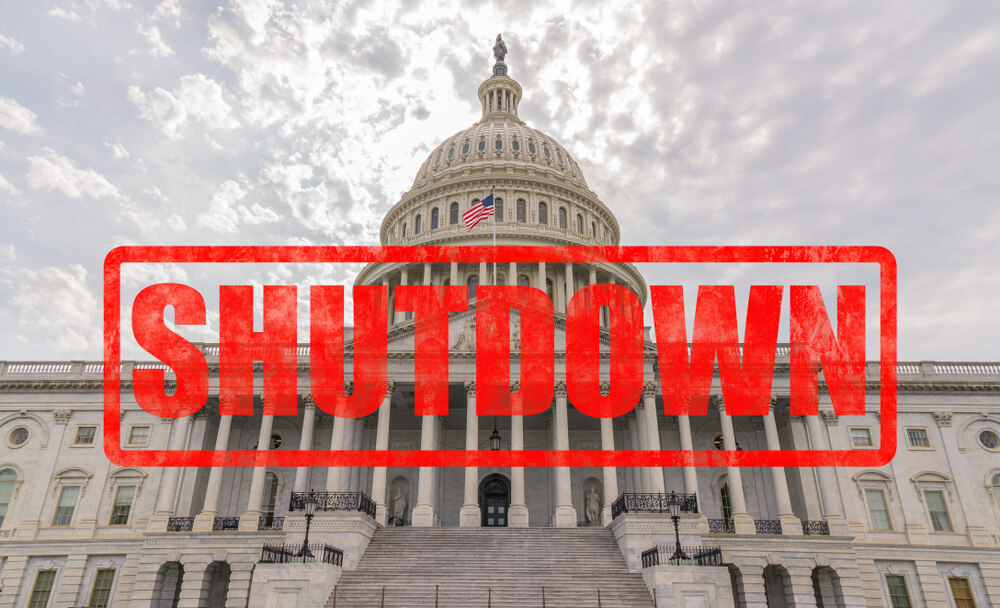The ongoing government shutdown over President Donald Trump’s proposed border wall set a new record for length on Jan. 14 and, according to analysts, investors won’t be able to ignore it much longer.
“Bad things come in threes, or so goes the old saying, and the government shutdown looks like the third in a series of a policy missteps that have undermined the expansion and pushed the probability of a recession to the highest level since early 2007.”
“Two key risks that we highlighted in the past (Fed’s monetary policy and trade war) have subsided, but new risks have emerged: U.S. government shutdown and signs of additional slowdown outside the U.S.,” JPMorgan’s global head of quantitative and derivatives strategy, Marko Kolanovic, wrote in a note this week.
Shutdowns haven’t historically had a tremendous impact on the stock market and that’s been the case so far with the current one, which entered its 27th day Thursday. But the longer it goes on, the worse things will get for everyone, and there’s no way around that.
Trump is seeking $5.7 million in the current spending bill to build his long-promised border wall between the U.S. and Mexico. House Democrats, having taken control earlier this month, aren’t budging.
Per MarketWatch:
The rebound has been attributed in part to a softer tone from the Federal Reserve when it comes to future rate increases, efforts by China to stimulate its economy, and a relative lack of negative news surrounding the U.S.-China trade spat. But analysts and others have begun to warn that the shutdown could begin to have a negative economic impact that poses to be a drag on the market.
“Bad things come in threes, or so goes the old saying, and the government shutdown looks like the third in a series of a policy missteps that have undermined the expansion and pushed the probability of a recession to the highest level since early 2007,” said Steven Blitz, chief U.S. economist at TS Lombard, in a Wednesday note, citing New York Federal Reserve Bank data.
The other missteps include the trade battle with China, which has undercut the benefits of the corporate tax cuts, and the Federal Reserve’s belief that “the effect on term yields from the pace of [its balance-sheet reduction] was somehow immune to a doubling of the budget deficit,” he said.
Blitz expects the U.S. and China will reach a lasting truce, the Fed will recalibrate the pace of its balance-sheet runoff and the government, of course, will reopen. “What matters is the timing of these developments in determining how quickly markets respond before greater damage is done to the economy,” he said.
The White House has reportedly doubled its own estimate of the shutdown’s impact on economic growth, news reports said Tuesday, forecasting it would trim first-quarter gross domestic product by 0.5 percentage points if it lasts through January.
The Wall Street Journal on Wednesday reported that some senior White House officials are privately advising Trump to find a way to end the shutdown. The officials are worried that the president hasn’t realized the severity of 800,000 federal workers missing paychecks, one official told the newspaper.
Gregory Daco, chief U.S. economist at Oxford Economics, estimated the shutdown would shave 0.2 percentage points off first-quarter GDP if it lasts through January, which would bring the firm’s GDP tracker down to 1.9% annualized growth. If it lasts through the end of March, it would shave off 0.6 percentage point, slowing the pace of growth to 1.5%, he said.
JPMorgan Chase Chief Executive Jamie Dimon, who’s been upbeat on the U.S. economy, warned Tuesday that the partial shutdown could wipe out growth if it lasts the entire quarter.
Meanwhile, the shutdown has deprived traders, economists and policy makers of at least 10 key government data releases so far, including figures related to housing, trade and consumer spending, Daco said, adding that even when the government reopens, it will likely take months to return to a normal schedule.
“If anything, this lack of data will favor an even-more cautious approach from the Fed when it comes to normalizing monetary policy. This is particularly true since the latest inflation data (which comes from the funded Bureau of Labor Statistics) shows no imminent risk of an outbreak,” he said.




